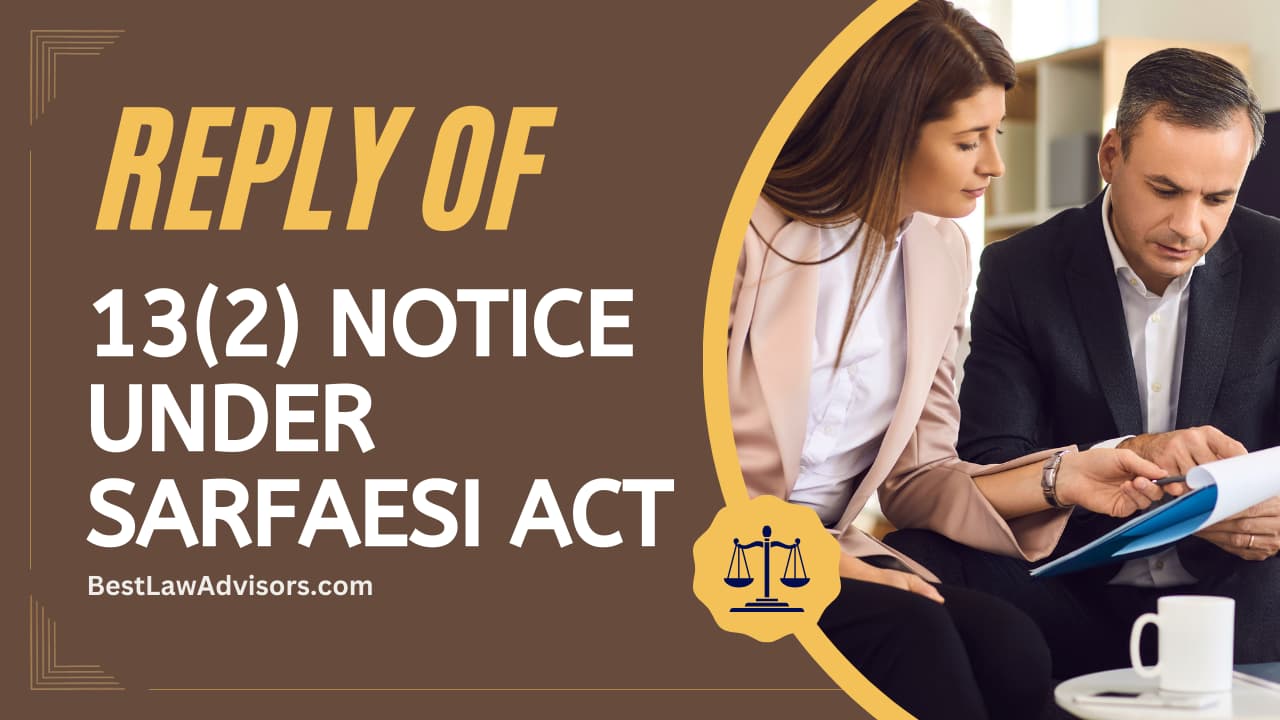In recent times, builders have been attracting buyers to invest their hard-earned money into their projects with tempting schemes like subvention schemes, buyback schemes, and more.
Many reputed builders promise to make pre-EMI payments on the home loan till possession or for a specified period under such schemes.
However, buyers are now facing difficulties when builders fail to fulfill their promises and banks start demanding loan repayment from the buyers.
Consequently, buyers receive legal notices from banks under section 13(2) of the SARFAESI Act, 2002.
Sample Reply to Notice Under Section 13(2) of Sarfaesi Act

This article discusses the key challenges faced by such buyers and the remedies available regarding the legal notice under section 13(2).
Key Challenge Arises for Buyers:
Buyers are facing the below key challenges related to home loans under attractive builder schemes:
- Delay in possession – Builders do not complete the project and hand over possession to buyers as per schedule.
- Builders stop paying pre-EMIs – As a result of delayed possession, builders stop making pre-EMI payments to the bank as promised to buyers.
- Banks demand loan repayment from buyers – Due to non-receipt of pre-EMIs, banks start chasing buyers demanding payment of pending EMIs, principal, interest, penalties, and other dues.
- Notices under SARFAESI Act section 13(2) – Buyers receive legal notices from banks under section 13(2) of the SARFAESI Act, 2002 to repay the pending dues.
Some alluring investment schemes offered by builders:
- Subvention schemes
- Assured return plans
- Buyback guarantees
- Payment plans linked to construction milestones
Remedy About the Legal Notice Received u/s 13(2)
If you have received any legal notice from the bank under section 13(2) of the SARFAESI Act, 2002, then you can take the below steps:
Verify notice details
- Carefully go through the notice details like loan account number, due amounts, timeline, consequences of non-repayment, etc.
- Confirm whether the demanded amounts are actually pending or already paid – Banks often make mistakes in calculating pending dues.
- Check if any additional charges like penalties, interests, etc are inaccurately levied.
Review agreement clauses
- Go through the terms and conditions agreed with the builder and bank.
- Check the builder’s liability to make pre-EMI payments till possession and compare with notice claims.
- Review if there are any breaches from the builder or bank as per agreement clauses.
Send detailed reply to notice
- Draft a detailed reply denying allegations and inaccurate claims in the notice.
- Specify applicable agreement clauses showing the builder’s responsibility for such payments.
- Provide documentary proof of payments already made.
- Send written reply through registered post with acknowledgment due.
- Maintain a reply copy for future reference.
Tips Before Sending 13(2) Notice Reply:
- ✔ Highlight inaccuracies in demanded amounts
- ✔ Specify relevant agreement clauses
- ✔ Attach supporting payment proofs
- ✔ Send thorough written reply on time
Sample Reply to Notice Under Section 13(2) of Sarfaesi Act – Notice Format
The Sample Reply to Notice Under Section 13(2) of Sarfaesi Act, 2002 can be on the below lines:
Date: DD/MM/YYYY
To,
The Branch Manager
XYZ Bank
Branch addressSub: Response to the legal notice dated __________ u/s 13(2) received against loan account no.______________________
Sir,
This has reference to your legal notice dated ______ issued under section 13(2) of the SARFAESI Act, 2002 received on date ________ directing me to repay the outstanding amount of Rs. _____ towards loan account number ____________within 60 days.
I state that your allegations towards non-repayment of outstanding loan are false and incorrect due to the below reasons:
1) The tripartite agreement signed between bank, builder and me dated ________has the clause of the builder making all payments towards loan a/c no.__________ till handover of physical possession.
2) The builder has failed to provide completed flat possession as per agreement terms as of date.
3) As per section L, clause 7.a of tripartite agreement, it is the liability of builder to repay any loan due including interests, pre-EMIs etc.
I have already made part-payments of Rs.___ towards loan principal/interest/charges as of __________ (provide payment proofs). These amounts are not considered while stating inflated outstanding dues from me in your notice.
Therefore, the notice allegations are wrong, misconceived and hence denied in entirety. Please take up the issue of outstanding dues and loan non-repayments with the concerned builder directly as per the agreement.
I have sent a copy of this reply to builder as well for necessary action.
In case of any clarifications please contact me on email/phone.
Your’s Sincerely
Name
Contact Address
ID Proof:
CC: Builder
Sarfaesi 13(2) Notice Format PDF
The standard 13(2) notice format sent by banks under SARFAESI Act, 2002 is given on the next page:
Fig 1: Sample Format of 13(2) Notice under SARFAESI
The above is the typical 13(2) notice format issued by banks comprising sections like amount due, notice date, repayment demand date, action threat for non-payment, etc.
Buyers can customize the sample reply format as per the details of the notice.
FAQs on How to Reply Of 13(2) Notice under SARFAESI Act:
- Q1. Can buyers contest the wrong 13(2) notice under SARFAESI?
Yes, buyers can legally contest any inaccurate or false claims made in 13(2) notices by sending a written reply with supporting documents.
- Q2. What are the consequences of not replying to 13(2) notice?
If buyers don’t reply to 13(2) SARFAESI notice then the bank can take direct possession of the mortgaged property within 60 days.
- Q3. How much time do buyers have to reply to 13(2) notice?
Buyers must reply to the 13(2) notice under the SARFAESI Act within 60 days from the date of receiving such notice.
- Q4. Can banks directly auction property after issuing 13(2) notices?
No, banks have to mandatorily wait for 60 days after sending 13(2) notices for buyer reply before taking auction-related actions.
- Q5. Can builders be made a party to 13(2) notice replies?
Yes, builders should be marked in 13(2) notice replies by buyers to make them aware of the non-fulfillment of agreement clauses from their end.
- Q6. What details must buyers review before drafting 13(2) replies?
Buyers must study notice details, and review agreement terms between bank-builder-buyer, payment proofs, etc. before sending 13(2) notice responses.
- Q7. Is a physical copy of 13(2) responses mandatory?
Buyers should send a hard copy of a detailed 13(2) notice reply through the registered post as court-submitted evidence.
- Q8. How can buyers follow up after sending 13(2) notice replies?
Buyers can follow up with the bank through emails, calls, written reminders, etc. requesting loan recovery from the builder as per signed agreements.
- Q9. Is legal counsel necessary while replying to 13(2) SARFAESI notice?
Yes, buyers should consult and take the help of a lawyer to send an accurate legal response to 13(2) notices adhering to regulatory provisions.
- Q10. Can buyers straightaway file a case without sending 13(2) reply?
No, sending a detailed written reply to 13(2) notices is mandatory before buyers can approach legal authorities against the wrong bank recovery.
Disclaimer
The article is based on the writer’s understanding of industry practices and regulatory provisions. Readers are advised to consult legal and financial experts before making any real estate or loan related decisions.
Conclusion:
The builders often use tempting schemes like subvention schemes, assured returns, etc to attract property buyers and investors. However such buyers end up facing hardships when builders fail to fulfill payment promises as part of the scheme agreements.
Consequently, banks start harassment and pressure tactics demanding their loan payment dues from the property buyers. Hence buyers need to respond appropriately to any legal notices like that under section 13(2) issued by banks under the SARFAESI Act.
The written reply should highlight inaccurate claims and wrongful recovery attempts by specifying relevant agreement clauses and terms.
This can help buyers contest inappropriate recovery pressure from banks when the fault lies with non-compliant builders.
Consulting legal experts and advisors can further aid buyers in taking suitable steps to safeguard them from potential damages relating to faulty builder agreements and loans.



